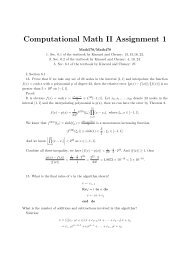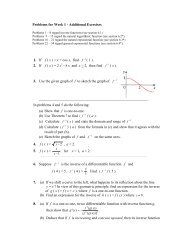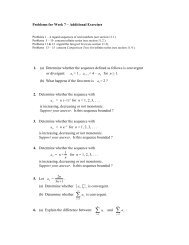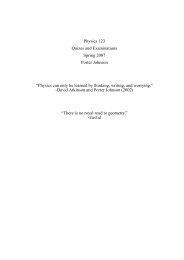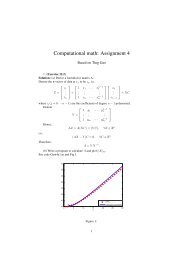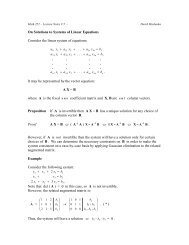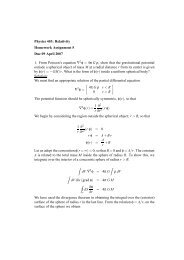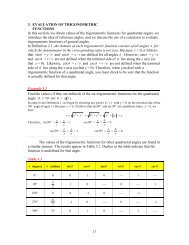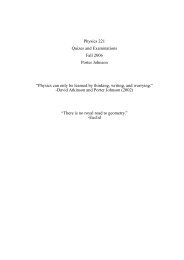HW 1 Exercises # 1
HW 1 Exercises # 1
HW 1 Exercises # 1
Create successful ePaper yourself
Turn your PDF publications into a flip-book with our unique Google optimized e-Paper software.
Homework 1 - Additional <strong>Exercises</strong>Problems 1 – 8 regard inverse functions (see section 6.1) and problems 9 – 15 regard the naturallogarithmic function (see section 6.2*).−11. If f ( x ) = x + cos x, find f ( 1 ).2. If f ( x ) = 2 x 2 − 8 x and x > 2, then find−1f ( x ).3. Use the given graph of f to sketch the graph of−1f .___________________________________________________________In problems 4 and 5 do the following:(a) Show that f is one-to-one.(b) Use Theorem 7 to find ( f −1 )′( a ).−1−1(c) Calculate f ( x ) and state the domain and range of f .(d) Calculate ( f−1 )′( a ) from the formula in (c) and show that it agrees with theresult of part (b).−1(e) Sketch the graphs of f and f on the same axes.4. f ( x ) = x − 2 , a = 2.15. f ( x ) = for x > 1, a = 2.x −1____________________________________________________________________________________________________________________________________________________________________________6. Suppose−1f is the inverse of a differentiable function f and2f ( 4 ) = 5, f ′ ( 4 ) = . Find (−f 1 ) ′ ( 5 ).37. (a) If we shift a curve to the left, what happens to its reflection about the liney = x ? In view of this geometric principle, find an expression for the inverseof g ( x ) = f ( x + c ), where f is a one-to-one function.(b) Find an expression for the inverse of h ( x ) = f ( cx ) where c ≠ 0 .8. (a) If f is a one-to-one, twice differentiable function with inverse function g,f ′′(g(x))then show that g′ ( x)= − .3[ f ′(g(x))](b) Deduce that if f is increasing and concave upward, then its inverse functionis increasing and concave downward.
2⎛ r9. Use the Laws of Logarithms to expand ⎟ ⎞ln ⎜.⎝ 3 s ⎠2 210. Use the Laws of Logarithms to expand ln a ( b + c ) .__________________________________________________________In problems 11 and 12 do the following:Make a rough sketch of the graph of each function. Do not use a calculator. Just usethe graph of y = ln x shown in the figure and, if necessary, the transformations ofSection 1.3.11. y = ln | x |12. y = ln ( x + 3 )_______________________________________________________________________________________________________________________________________________________________________________13. Differentiate f and find the domain of f if f ( x ) = ln ( ln ( ln ( x )) ) .14. If g is the inverse of f ( x ) = 2x + ln x, find g′ (2).ln(1 + x)15. Use the definition of the derivative to prove that lim = 1.x→0 x



